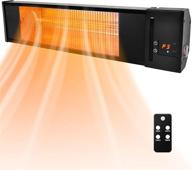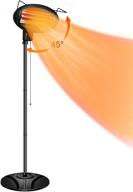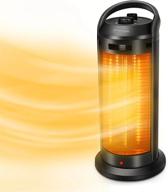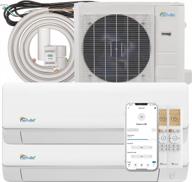
Review on 🔥 Ashley Hearth DVAG11N 11,000 BTU Direct Vent Natural Gas Heater in Cream: Efficient Heating Solution for Your Home by Justin Falker

Demand heat in annex (remote bedroom)
I bought a house with annex with electric heating. We turned on the electric heat last fall and saw an immediate increase in our electric bills from 70 => 170. Given the options, this product seemed like the solution. I didn't have natural gas near where we need heat. So think of this as a two-part project. Gas supply to the construction site, installation of a heater. Proceed when installing the stove: 1) Consider the place as the coldest point in the room or the place farthest from other heat sources. 2) Consider how the exhaust will interact with the structure, windows, doors and traffic. 3) Find your studs and make a pilot hole to see what's behind the drywall. I found a power line that I had to account for. I ended up moving the heater 6 inches higher than I originally planned. 4) Cut out the required square hole on the inner and outer wall. It's easy to say, but it takes time to get it right. 5) I closed the hole in such a way that it does not let air through either from the inside or the outside. This was not discussed in the instructions. I used drywall and materials I had on hand. 6) Use the metal box included in the kit included in the hole. 7) I tried using wall mounts but they were cheap (as others have mentioned), replace them with good decking screws. Mount the heater on an interior wall. 8) Cut the pipes and threaded rod according to the instruction formula. Make sure the pipes are sloped slightly to allow moisture to drain. 9) The outer panel has no fasteners, mainly glued to the fairing. I ended up using a whole tube of silicone caulk, I marked the wall to figure out the desired final position of the outer panel. I used a threaded rod to push the outer panel against the wall, but in my case it wasn't enough to hold the panel while the sealant dries. My siding is vinyl so I didn't want to use nails etc. to temporarily hold the disk. I ended up using spare pipe to install the bottom edge and a threaded rod to pull the panel to the siding. After 24 hours the performance was finished. Inside the house I put a metal heat shield over the heater to avoid high temperatures directly above the drywall heater. I read that many others describe the wall as very hot. Time will tell if this is a good decision or not. I will report later on about the gas installation. Part 2) I used black pipe and CSST (corrugated stainless steel pipe) to feed the heater with natural gas. The CSST is easy to route, just validate the code, to me it should be safe at any point under 6ft where damage can occur. I used black iron under 6 feet through the walls and CSST along the eaves. I then bled the fuel line to make it easier to start. I had a little problem with the knob, it wouldn't turn to the pilot's position. It appeared to have burrs at the button-to-button interface. The burr has been removed and it works as it should. The detonator fires easily and as it's a windy day today I can confirm blowing it off isn't that easy. As you turn the temperature control valve, you may hear a click as it moves from the pilot area to the temperature control area. The temperature is set at 2, a good low fire. The windows are open and the exhaust fan because the new metal has a strong smell. I let it simmer for an hour and opened all the windows with the exhaust fan on. Tonight the smell has subsided and I no longer smell any other odors. At the lowest setting, it turns on and off depending on the room temperature. Seems to be working very well. refinement point. I put a heating plate on the wall above the heater to keep the drywall from overheating. Seems to be working very well. Minimal usage at the moment so I'll update when I use it. Second, I have vinyl siding on the outside, and I'm a little concerned that the heat will damage the siding. I used magnets to attach the aluminum grille to the metal panel (outlet and inlet). Magnets hold the aluminum against a metal plate. I want to avoid the problem, so I can't honestly say that would be a problem. I see no lack of a little caution. More information after a few weeks of use.
- Approved for use in mobile or modular homes
- Crumpled
New products
Comments (0)
Top products in ♨️ Space Heaters

1500W PTC Ceramic Electric Space Heater With 60° Oscillating Tower Fan, Thermostat & Overheat/Tip-Over Protection For Office Home Bathroom Large Room Indoor Use (32 Inch)

51 Review

Stay Warm And Cozy With TRUSTECH'S Efficient Garage Heater - Fast Heat, Timer, Overheat Protection, And Waterproof Design

46 Review

TRUSTECH Outdoor Patio Heater - Adjustable 1500W Waterproof Heater With Rapid 3-Second Heating, IP34 Protection, And Tip-Over Safety Feature For Balcony, Backyard, And Garage Use

45 Review

Stay Warm And Comfortable With The 2-In-1 Space Radiant Heater: 120° Oscillation, 1500W Power, 4 Heating Modes, Dual-Protection, And Quiet Fast Heating For Indoors And Outdoors

37 Review
Another interesting products

🥶 LG TC09GQR Split System Air Conditioner - White

11 Review

Split system Roda RS-AL09F / RU-AL09F

37 Review

White Senville Dual Zone Mini Split Air Conditioner Heat Pump, 28000 BTU, Alexa Compatible - SENA-30HF/D

21 Review

🥛 Electrolux EACS-12HG2/N3 Split System Air Conditioner with Milk Cooling Feature

12 Review

